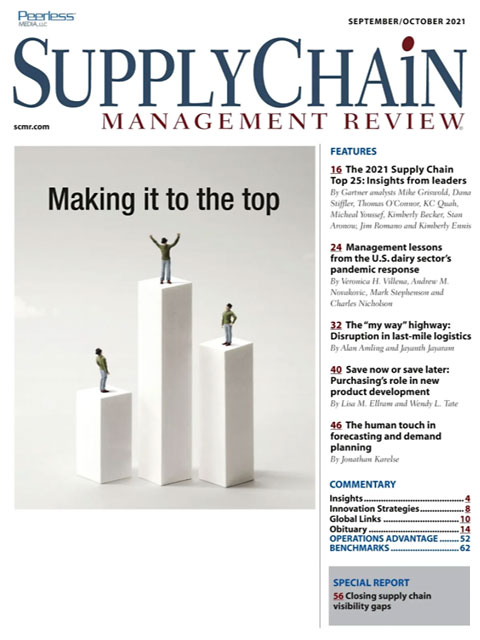Sorry, but your login has failed. Please recheck your login information and resubmit. If your subscription has expired, renew here.
September-October 2021
This time every year, we publish Gartner’s Top 25 supply chains, the annual list of the supply chains that have made it to the top, a list that now also includes 5 Masters, or companies that have consistently outperformed year after year. You can read the article in this issue, along with the web exclusive material we publish on scmr.com, to find out what it takes to become a supply chain leader. Browse this issue archive.Need Help? Contact customer service 847-559-7581 More options
Much attention is being paid to the various methods by which the computer-aided automation of—primarily—autoregressive forecasting can be undertaken. And with good reason. Artificial Intelligence, Machine Learning and a host of other technologies represent remarkable developments in the forecasting world. They hold the promise of better leveraging the efforts and insights of demand planners at learning what their order history can tell them about the future.
For SKUs with a particular demand profile, there is little question that forecast automation may yield a significant improvement in both performance and cycle time, provided there are no substantive changes in demand in the future. Nearly all businesses, however, have items whose demand profiles do not lend themselves well to autoregressive forecasting, and there is no business that can’t benefit from the judicious application of human input under the appropriate circumstances. Leading forecast researchers Paul Goodwin and Robert Fildes have demonstrated this over long periods of observation.
Whatever the profile of a company’s demand, and whatever its degree of automation, there are nevertheless multiple touchpoints where human intervention can consciously or unconsciously transmit biases into the demand planning process. Indeed, my company, NorthFind Management, worked with a number of multi-billion-dollar global manufacturers to understand the prevalence of biases and heuristics in the general population within the organization, and specifically in demand planners.
How biases influence planning
From the inception of demand planning, unconscious biases and heuristics have influenced the sources of data that planners consider or exclude as part of the demand plan. For example, if the prevailing wisdom in an organization holds that their business is unique—a sentiment held by most companies—there may be a reluctance to invest in mining syndicated channel data for additional insights into demand, despite the probability that, when properly used this source of data yields benefits. In this case, two prevailing biases—Availability Heuristic and Groupthink—unconsciously bias the demand planner and, as a result, directly influence the entire planning process.

This complete article is available to subscribers only.
Log in now for full access or start your PLUS+ subscription for instant access.
SC
MR
Sorry, but your login has failed. Please recheck your login information and resubmit. If your subscription has expired, renew here.
September-October 2021
This time every year, we publish Gartner’s Top 25 supply chains, the annual list of the supply chains that have made it to the top, a list that now also includes 5 Masters, or companies that have consistently… Browse this issue archive. Access your online digital edition. Download a PDF file of the September-October 2021 issue.Much attention is being paid to the various methods by which the computer-aided automation of—primarily—autoregressive forecasting can be undertaken. And with good reason. Artificial Intelligence, Machine Learning and a host of other technologies represent remarkable developments in the forecasting world. They hold the promise of better leveraging the efforts and insights of demand planners at learning what their order history can tell them about the future.
For SKUs with a particular demand profile, there is little question that forecast automation may yield a significant improvement in both performance and cycle time, provided there are no substantive changes in demand in the future. Nearly all businesses, however, have items whose demand profiles do not lend themselves well to autoregressive forecasting, and there is no business that can’t benefit from the judicious application of human input under the appropriate circumstances. Leading forecast researchers Paul Goodwin and Robert Fildes have demonstrated this over long periods of observation.
Whatever the profile of a company’s demand, and whatever its degree of automation, there are nevertheless multiple touchpoints where human intervention can consciously or unconsciously transmit biases into the demand planning process. Indeed, my company, NorthFind Management, worked with a number of multi-billion-dollar global manufacturers to understand the prevalence of biases and heuristics in the general population within the organization, and specifically in demand planners.
How biases influence planning
From the inception of demand planning, unconscious biases and heuristics have influenced the sources of data that planners consider or exclude as part of the demand plan. For example, if the prevailing wisdom in an organization holds that their business is unique—a sentiment held by most companies—there may be a reluctance to invest in mining syndicated channel data for additional insights into demand, despite the probability that, when properly used this source of data yields benefits. In this case, two prevailing biases—Availability Heuristic and Groupthink—unconsciously bias the demand planner and, as a result, directly influence the entire planning process.
SC
MR


Latest Supply Chain News
- Made in Mexico, manufactured by China
- Retail sales see gains in October, reports Commerce and NRF
- Balancing green and speed: Home delivery insights from the pandemic era
- AdventHealth named top healthcare supply chain by Gartner
- Geopolitical readiness in supply chains: Strategic challenges for leaders
- More News
Latest Podcast

 Explore
Explore
Procurement & Sourcing News
- Made in Mexico, manufactured by China
- Retail sales see gains in October, reports Commerce and NRF
- Geopolitical readiness in supply chains: Strategic challenges for leaders
- With capacity to spare, logistics real estate demand remains subdued
- Tariffs, taxes and trade: The impact of Trump’s reelection on the supply chain
- How to improve demand forecasts for new product families
- More Procurement & Sourcing
Latest Procurement & Sourcing Resources

Subscribe

Supply Chain Management Review delivers the best industry content.

Editors’ Picks





